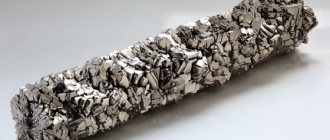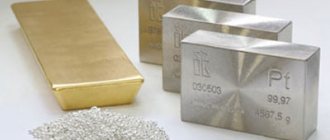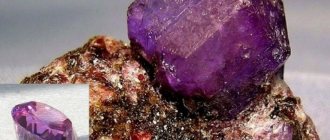Rules for exporting gold abroad have been changed
From April to June, the profit from the export of gold abroad turned out to be greater than the income from the sale of natural gas abroad. This is confirmed by data from the Central Bank of the Russian Federation and state customs structures. From April to May, gold exports from Russia in monetary terms amounted to $3.55 billion. While the “blue fuel” sent abroad brought Gazprom only $2.4 billion. In total, from mid-spring to June, $3.5 billion worth of gas was sold outside Russia.
The second quarter of 2021 showed the lowest gas exports since 2002. Sales volumes were three times lower than in the first quarter and decreased five times compared to 2010.
This decrease in demand for gas supplies is caused by the consequences of quarantine restrictions associated with the spread of COVID-19. The so-called Blue Stream, a gas pipeline in the direction of Turkey, has been suspended.
The cost of gas exports from Russia has halved compared to 2019. Now 1000 cubic meters costs only $94. Such prices do not provide Gazprom with production profitability of $105 per thousand cubic meters.
The export of gold abroad from April takes place according to new rules. Now banks, refineries and gold mining companies have equal rights to export precious metals. Export supplies from Russia have already begun to grow. Experts predict a further increase in gold sales abroad. The global economic crisis has spurred demand for the yellow metal. Domestic gold miners, due to high production volumes, can ensure supply on the international market. Restoring the demand for gas resources will take a long period.
Gold exports from Russia have become significantly easier since April, thanks to the possibility of obtaining a general license for producers for all subsequent export operations at once. Let us recall that previously each foreign contract required a separate permit.
The need for such changes in the rules for the export of gold is caused by the cessation of government purchases of the precious metal from domestic mining companies. The Central Bank of the Russian Federation stopped replenishing the country's gold reserves, which simply blocked gold miners' main sales channel for their products. Gold producers were asked to independently organize exports abroad. And the new rules for the export of precious metals are designed to help them with this.
Countries leading gold consumption in the world
Speaking about gold consumption, we are primarily talking about the use of gold in the jewelry industry (70-80% of total consumption), as well as its use in electronics, medicine and other industries. Thus, the leaders in consumption at the end of 2021 were:
- China - 785.2 t
- India - 700.5 t
- USA - 156 t
- Japan - 99.9 t
- Türkiye - 98.4 t
- Italy - 83.6 t
- South Korea - 80.9 t
- South Africa - 70.7 t
- Iran - 62.8 t
- Indonesia - 49.1 t
In total, 2816.5 tons of gold were used in the world in 2021. Moreover, the most active demand for gold consumption comes from the countries of the Asian region. Russia's consumption at the end of 2021 amounted to 47.4 tons , it took 11th place right after Indonesia.
You can see the full statistics of gold consumption by country in the table below under the spoiler:
Expand the table of gold consumption in countries around the world
| A country | Gold consumption, t |
| The whole world | 2816.5 |
| China | 785.2 |
| India | 700.5 |
| USA | 156 |
| Japan | 99.9 |
| Türkiye | 98.4 |
| Italy | 83.6 |
| South Korea | 80.9 |
| South Africa | 70.7 |
| Iran | 62.8 |
| Indonesia | 49.1 |
| Russia | 47.4 |
| Germany | 43.7 |
| UAE | 42.7 |
| Switzerland | 35.7 |
| Saudi Arabia | 34.4 |
| Malaysia | 30.1 |
| Singapore | 28.2 |
| Canada | 25 |
| Thailand | 24.7 |
| Egypt | 24.5 |
| Taiwan | 23.9 |
| Brazil | 23.8 |
| Great Britain | 21.4 |
| Vietnam | 20 |
| Pakistan | 17.9 |
| Australia | 12.7 |
| Austria | 12.5 |
| Kuwait | 11.8 |
| Jordan | 11.4 |
| Sri Lanka | 9.8 |
| Mexico | 9.6 |
| Uzbekistan | 8.3 |
| Lebanon | 8.1 |
| France | 6.8 |
| Morocco | 6.3 |
| Kazakhstan | 6 |
| Bahrain | 5.6 |
| Spain | 5.3 |
| Israel | 5.1 |
| Greece | 3.9 |
| Iraq | 3.6 |
| Oman | 3.2 |
| Myanmar | 3 |
| Poland | 2.8 |
| Libya | 2.8 |
| Nepal | 2.6 |
| Chile | 2.5 |
| Philippines | 2.4 |
| Netherlands | 2.2 |
| Costa Rica | 1.8 |
| Hong Kong | 1.8 |
| Qatar | 1.8 |
| Portugal | 1.5 |
| Bangladesh | 1.5 |
| Czech | 1.1 |
| Belgium | 0.8 |
| Luxembourg | 0.2 |
| Finland | 0.1 |
Peculiarities
Jewelry transported across the border is most often the personal belongings of individuals who do not have criminal intent. It is noteworthy that women do not so often travel “hung with jewelry,” which cannot be said about men wearing wristwatches worth more than 1 million rubles. When going abroad, it is necessary to declare all products made of precious metals, the total value of which exceeds 1 million rubles. If you ignore this procedure, there is a risk of being prosecuted.
The value of jewelry is assessed independently, taking into account their wear and tear. If you plan to value them below their actual value, then it is possible that you may become the object of close attention from the customs service. Because customs officers have all the necessary professional skills and can evaluate a product made of precious metals no worse than a jeweler. Any discrepancy is fraught with trouble.
What is mandatory labeling of jewelry?
The introduction of unified accounting using QR codes, which are planned to be applied to gold, palladium and platinum products using a laser, is designed to protect buyers from falsification and fraud. The regulator strives to suppress the shadow market and unscrupulous entrepreneurship - both in the field of sales of synthetic counterfeits and smuggling, and in terms of inflating the cost of sold jewelry.
Experts emphasize that it is currently impossible to imitate physical markings, the application of which is within the competence of the Federal Assay Office, which means that the end consumer is guaranteed to receive a high-quality product that meets the declared parameters.
Nuances for antique products
Antique jewelry created 100 years ago or more is considered cultural property. They are exported outside the EEAS in accordance with Appendix No. 8 to the Decision of the EEC Board of April 21, 2015 No. 30.
Citizens export cultural property in accordance with the procedure for moving things for personal use across the customs border of the EAEU. For export, you must obtain a permit - a conclusion from the Ministry of Culture of the Russian Federation or its territorial body in 2 copies, each of which is certified by a seal. The conclusion is accompanied by a bound list and photographs of cultural property permitted for export, also certified by the seal and signature of an official of the Ministry of Culture.
The permit document is presented to the customs inspector along with the PDD, which indicates the details of the conclusion. In case of export of numismatic items, photographs are not required.
An individual has the right to export valuables imported into Russia on the basis of the PDD filled out upon import. Legal entities have the right to export cultural property only on the basis of a license issued in accordance with the Instructions on the execution of an application for a license for the export and (or) import of certain types of goods and on the execution of such a license, approved by the Decision of the EEC Board of November 6, 2014 No. 199.
Monitoring system
Labeling of gold (as well as other) jewelry in Russia by 2022 should ensure the functioning of a system in which each market participant records the transactions he performs in the accounting register. All consignments of goods are provided with accompanying inventories indicating identifiers, and entities involved in trade turnover have the opportunity to carry out a reconciliation report, in which scanning barcodes makes it possible to confirm the compliance of the declared data.
Tasks of GIIS DMDK
Since the development of the draft program, the range of goals pursued has not actually changed, but has become more specific:
- Introduction of special accounting of all counterparties active in the precious metals industry.
- Creating conditions for documentary tracking of the product distribution cycle - everything starts with raw material shipments and ends with the sale of finished products.
- Simplifying the exchange of information between system participants and supervisory authorities.
- Providing opportunities for comprehensive processing and analysis of data, allowing the generation of statistical and reference reports.
To organize interaction between industry subjects and GIIS DMDK, a personal profile is used, available on the operator’s official website. It is worth emphasizing that when registering for special registration, as well as when deregistering from it, information about the enterprise is checked in detail by the tax service, the Ministry of Internal Affairs and Rosfinmonitoring.
Implementation timeframe
As already mentioned, the government responded to industry feedback and decided to make concessions for business. As a result, in 2021 in Russia, markings on jewelry made of gold and other precious metals and stones are implemented in a trial format, allowing each organization to voluntarily prepare and join the GIIS DMDK. The mandatory registration date is March 1, 2022.
A year after this, physical laser identification of jewelry with QR codes that will be applied in the stamp area will become an essential condition, and the countdown of the 12-month period allotted for the sale of unmarked goods will begin. Well, in the spring of 2024, the system will begin to function in full - without exceptions or easing.
Residue marking
The procedure for including products actually at the disposal of retail outlets, wholesalers and other market participants into circulation is as follows:
The enterprise notifies the supervisory authorities about its available reserves, characterizing them in quantitative terms, and receives an appropriate set of digital identifiers - in the event that it has no debts to the Federal Tax Service, there are no unpaid fines and penalties, and an agreement has been concluded with Goznak.
The company produces and attaches an additional label to the product - indicating the code in graphical and numerical form, as well as a link to the official resource where you can check the information. The technical parameters of the equipment and software used must ensure the ability to print materials that meet the established standard, so if you are looking for a comprehensive solution, we recommend paying attention to proven options from Cleverence.
The accounting system records the characteristics of the object, including information about weight, fineness, presence of inserts, as well as a photograph of the decoration. The specific requirements for the design of tags when labeling jewelry are determined by the regulator’s desire to create conditions under which the buyer can at any time clarify the compliance of the product with the declared data, the legality of its origin, etc.
It is also important for producers and producers to take into account that the FPP must provide information not only on finished products, but also on inserts and precious metals, divided in accordance with supply contracts confirming their origin. Each batch receives its own code, indicated when releasing goods.
Legal basis
The decision of the EEC Board of April 21, 2015 No. 30 “On non-tariff regulation measures” established the procedure for moving across the customs border of the EAEU:
- precious metals (Appendix No. 14);
- precious stones (Appendix No. 13).
The conditions for the movement of valuables by individuals are established by Decision of the EEC Council dated December 20, 2017 No. 107.
Precious metals and stones, natural pearls and products made from them, as well as watches are included in the list of strategically important goods approved by Decree of the Government of the Russian Federation of September 13, 2012 No. 923. Responsibility for smuggling of such goods is regulated by Art. 226.1 of the Criminal Code of the Russian Federation.
Dynamics of gold mining in Russia since 1600
While writing this paragraph, I looked through quite a few different sources of information with statistics on gold production in Russia. It took more than 1 day to find excerpts of statistics from various official and unofficial sources. Statistics from the State Statistics Committee, the IMF, the Union of Gold Miners of the Russian Federation and others were used as official statistics. Unofficial sources include various studies and excerpts from the literature of experts in the field of the gold industry and economics.
It’s worth saying right away that for most of the time period since 1600, it was possible to unearth only approximate statistics on gold production. The greatest difficulty arose with finding information about gold mining in the USSR from 1921 to 1991, since this information is classified. However, some data was still found due to the fact that some of the information was declassified by the US CIA.
The dynamics of gold mining in Russia and the Russian Empire from 1600 to 1900 were only averaged, but they are extremely valuable:
- 1600 - 1740 - about 17.7 tons of gold were mined over 140 years
- 1740-1760 - average annual production was 40 kg of gold
- 1761-1780 - average annual production was 95 kg of gold
- 1781-1800 - average annual production was 130 kg of gold
- 1801-1810 - average annual production was 165 kg of gold
- 1811-1820 - average annual production was 315 kg of gold
- 1821-1830 - average annual production was 3375 kg of gold
- 1831-1840 - average annual production was 7050 kg of gold
- 1841-1850 - average annual production was 22.52 tons of gold
- 1851-1860 - average annual production was 25.65 tons of gold
- 1861-1870 - average annual production was 27.07 tons of gold
- 1871-1880 - average annual production was 37.97 tons of gold
- 1881-1890 - average annual production was 35.74 tons of gold
- 1891-1890 - average annual production was 40.13 tons of gold
It was possible to find statistics on gold production since 1900 in more detail by year, but some years are still missing. If you have more detailed information on the missing years, write it in the comments. You can view gold production statistics in Russia since 1900 in the graph below:
Data on gold production in Russia in recent years may vary slightly, depending on the source. So, according to data from the Union of Gold Miners, gold mining in Russia over the past few years is as follows:
- 2013 - 254.8 t
- 2014 — 288.5 t
- 2015 — 293.8 t
- 2016 — 297.4 t
- 2017 — 318.1 t
- 2018 — 329.9 t
In other words, according to these statistics, Russia for the first time began to produce more gold than during the Soviet era.
And that’s all for today about gold mining in Russia and countries around the world. Add the article to bookmarks and share with friends. Subscribe to new articles by e-mail, good luck and see you again on the pages of the Tyulyagin !
- 23
Shared











